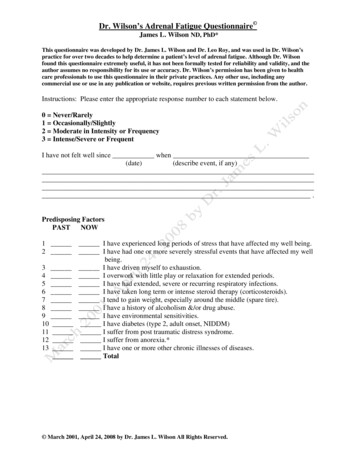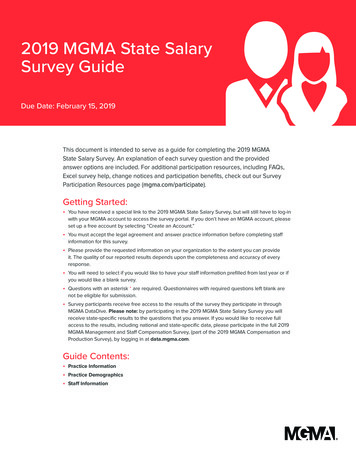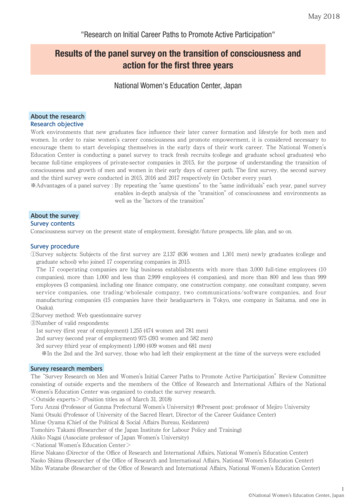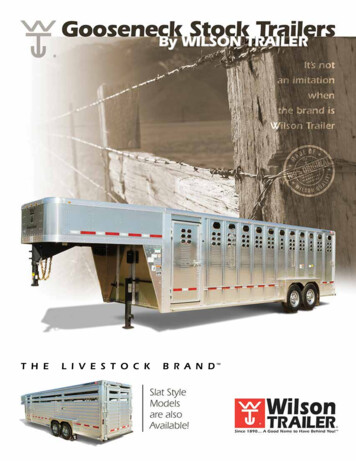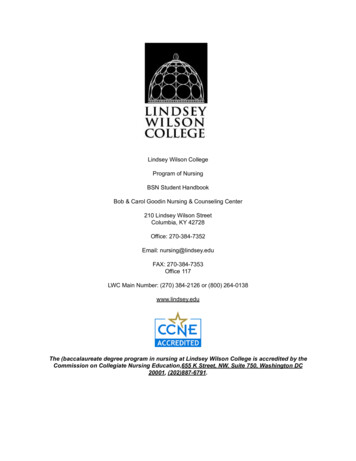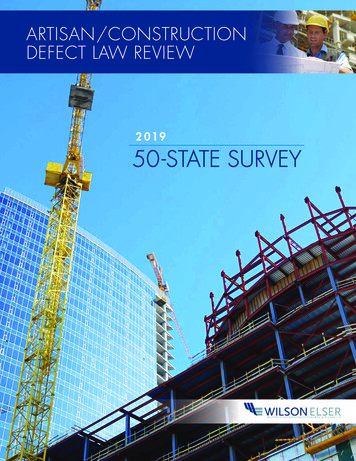
Transcription
ARTISAN/CONSTRUCTIONDEFECT LAW REVIEW2 01950-STATE SURVEY
CONTENTS1Alabama55Louisiana108 Oklahoma4Alaska59Maine110 Oregon7Arizona62Maryland113 Pennsylvania10Arkansas65Massachusetts116 Rhode trict of ada33Hawaii89New Hampshire35Idaho92New Jersey39Illinois95New Mexico42Indiana97New York145 Wisconsin45Iowa99North Carolina148 Wyoming48Kansas102 North Dakota151 Our Firm51Kentucky105 Ohio152 Offices118 South Carolina121 South Dakota124 Tennessee127 Texas131 Utah134 Vermont136 Virginia139 Washington142 West VirginiaWilson Elser, a full-service and leading defense litigation law firm (www.wilsonelser.com), serves its clients with nearly 800 attorneysin 37 offices in the United States and one in London. Founded in 1978, it ranks among the top 200 law firms identified byThe American Lawyer and is included in the top 53 of The National Law Journal’s survey of the nation’s largest law firms. WilsonElser serves a growing, loyal base of clients with innovative thinking and an in-depth understanding of their respective businesses.Wilson Elser makes the material included in this volume available for general informational purposes only. The material is notintended to and does not constitute legal advice. Moreover, the material is not intended to and does not constitute a solicitationfor the formation of an attorney-client relationship and you should not act upon it without first seeking legal counsel. Wilson Elserreserves the right to correct, change or update this material at any time without prior notice.Unsolicited emails and information sent to Wilson Elser do not create an attorney-client relationship with Wilson Elser, will notbe considered confidential and may be disclosed to others pursuant to our Privacy Policy. Wilson Elser accepts clients only aftercompletion of certain formal procedures.
June 2019July 20172019 Artisan/Construction Defect Law Review2017 Artisan/Construction Defect Law ReviewClients, Friends and Colleagues:Clients, Friends and Colleagues:Wilson Elser is very pleased to provide our 2019 Artisan/Construction Defect Law Review,which addressesissues intothisclass ofby reviewing applicablestatutesWilsonElser is certainvery pleasedprovideourbusiness2017 Artisan/ConstructionDefectLawwhereReview,they existin additionto commonin eachthe 50 statesand ues inlawthisdevelopmentsclass of businessbyofreviewingapplicabletheyexist inadditionto commonin eachstatutesof the 50states and elopmentsour attorneys includeof limitations,statutesof ofColumbia.Someof the specificareaswesomeaddressincludethe statuteof limitations,statute ofrepose, certainapplicabledefenses,and incases,peculiaritiesof a givenstate.repose, certain applicable defenses, and in some cases, specific peculiarities of the given state.It must be recognized that the law on this subject continually changes, so this document shouldItthat the only.law onShouldthis subjectconstantlychanges andthis documentbemustused beforrecognizedreference purposesany matterarise involvingconstructiondefect erariseinvolvingconstructiondefectlitigation, the law in the particular jurisdiction should be reviewed as to its current status beforelitigation, the law in the particular jurisdiction should be reviewed as to its current status beforeany position is taken.any position is taken.As always, we are happy to direct you to the attorneys who practice in this area of the law and toAs always, we are available to discuss the various aspects of this review and look forward tothe various aspects of this review. We look forward to comments.comments.Sincerely yours,yours,SincerelyJonathanDryerJonathan DryerManaging Partner, PhiladelphiaWendyWendy D.D. TestaTestaPartner, Philadelphia
2019 ARTISAN/CONSTRUCTION DEFECT LAW REVIEWContributorsTaylor AllinPhoenixKathy ArlineOrlandoJoe BaioccoWhite PlainsLori BarkerNew OrleansMichael BeckelmanHoustonEric ChengWhite PlainsJames CopePhiladelphiaJonathan DryerPhiladelphiaJana FarmerWhite PlainsChristopher FlanaganBostonLindsay GrayKentuckyTiffany GruenbergLos AngelesRoss JonesBeaumontDavid KahnLas VegasGuy LevasseurWhite PlainsKaren MaschkePhiladelphiaJeffrey MelcherAtlantaJason MelicharDenverRoss MolinaNew OrleansEdward O’BrienKentuckyAnthony PietiMichiganCamille ShoraVirginiaParks StoneAtlantaWendy TestaPhiladelphiaEnrico TufanoPhiladelphiaMichael WeisenbachEdwardsvilleRyan WilliamsDenverSteven WillnerBaltimoreEditorsJacqueline HattarWhite PlainsPatrick McKnightPhiladelphiaArchitects & Engineers Co-chairArchitects & Engineers Co-chair
2019 ARTISAN/CONSTRUCTION DEFECT LAW REVIEWAlabamaALABAMAI.Statute of Limitations/Statute of Repose/Discovery RuleA.GeneralIn Alabama, a construction defect claim sounding in tort or contract must be commenced within two years.Alabama has adopted the “discovery rule,” which allows an action to be commenced, in certain instances,within two years from the date of the plaintiff’s discovery of any latent damage or defects. It should benoted that the discovery rule is limited to actions against an architect, engineer, or builder. Additionally,Alabama’s Statute of Repose provides that no claims in tort, contract or otherwise against any personperforming or furnishing the design, planning, supervision, or observation of construction or theconstruction of an improvement to real property may be brought more than seven years after the substantialcompletion of such improvement.B.Statute of LimitationsA cause of action in tort, e.g., negligent construction, accrues only when actual injury or damages aresustained. See Matthews Bros. Const. Co. v. Stonebrook Develop., 854 So. 2d 573 (Ala. Civ. App. 2001).In a breach of contract action, the cause of action accrues at the time of the breach regardless of whetheractual damage is sustained. Id. See also Alabama Power Co. v. Cummings, 466 So.2d 99 (1985) (holdingthat a homeowner’s cause of action for construction defects in her home accrued only when the defectsmanifested themselves).1.Statute of Limitations Regarding Alleged Construction DefectsAll civil actions in tort, contract, or otherwise against any architect or engineer performing or furnishingthe design, planning, specifications, testing, supervision, administration, or observation of anyconstruction of any improvement on or to real property, or against builders who constructed, or performedor managed the construction of, an improvement on or to real property designed by and constructed underthe supervision, administration, or observation of an architect or engineer, or designed by and constructedin accordance with the plans and specifications prepared by an architect or engineer, for the recovery ofdamages for: (i) any defect or deficiency in the design, planning, specifications, testing, supervision,administration, or observation of the construction of any such improvement, or any defect or deficiencyin the construction of any such improvement; (ii) damage to real or personal property caused by any suchdefect or deficiency; or (iii) injury to or wrongful death of a person caused by any such defect or deficiencyshall be commenced within two years next after a cause of action accrues or arises, and not thereafter.Alabama Code §6-5-221. 2019 Wilson, Elser, Moskowitz, Edelman & Dicker LLP1
2019 ARTISAN/CONSTRUCTION DEFECT LAW REVIEW2.Statute of Limitations of a Claim Brought Pursuant to the Deceptive TradePractices ActNo action may be brought pursuant to Alabama’s Deceptive Trade Practices Act more than one year afterthe person bringing the action discovers, or reasonably should have discovered, the act or practice whichis the subject of the action, but in no event may any action be brought more than four years from the dateof the transaction giving rise to the cause of action, unless the contract or warranty is for more than threeyears. If the contract or warranty is for more than three years, no action may be brought more than oneyear from the expiration date of the contract or warranty or more than one year after the person bringingthe action discovered or reasonably should have discovered the act or practice which is the subject of theaction, whichever occurs first. Alabama Code §8-19-14.3.Statute of Limitations of a Claim Brought Pursuant to a Breach of ImpliedWarranty of Habitability and Reasonable WorkmanshipThe statute of limitations for a breach of implied warranty of habitability claim, while limited to areasonable time, may not extend beyond the period allowed for filing suit on an express warranty, whichis six years. Sims v. Lewis, 374 So. 2d 298 (1979) (citing Alabama Code §6-2-34).4.Statute of Limitations of a Claim Brought Pursuant to a Breach of ExpressWarrantyThe statute of limitations in Alabama for a breach of express warranty action is six years. Alabama Code§6-2-34(9).5.Statute of Limitations of a Claim Based on FraudFraud claims are subject to a two-year statute of limitations. That statute of limitations is subject to the“saving clause,” which states that actions seeking relief on the ground of fraud where the statute hascreated a bar, the claim must not be considered as having accrued until the discovery by the aggrievedparty of the fact constituting the fraud, after which he must have two years within which to prosecute hisaction. Alabama Code §6-2-38(l); Alabama Code §6-2-3.C.The Discovery Rule in Relation to Tolling the Statute of Limitations inActions Involving Construction DefectsAlabama Code §6-5-220(e) permits certain plaintiffs to file an action within two years from the date ofdiscovery of any latent damage or defect. This discovery rule is limited to actions against an architect,engineer, or builder, as defined in Alabama Code §§6-5-220 through -228. Turner v. Westhampton Court,L.L.C., 903 So.2d 82 (2004). 2019 Wilson, Elser, Moskowitz, Edelman & Dicker LLP2
2019 ARTISAN/CONSTRUCTION DEFECT LAW REVIEWD.Statute of ReposeAlabama’s statute of repose bars construction claims commenced after 13 years. The statute of reposedoes not apply if the builder had actual knowledge of the defect and failed to disclose it. Alabama Code§6-5-221. Additionally, Alabama has a second statute of repose that applies only to “improvement” ofreal property that bars construction claims commenced after seven years from the date of substantialcompletion. Alabama Code §6-5-218(a).II.Common Law Related to Construction Defect Claims: Trigger for Coverage under a CGLPolicy for Property Damage Allegedly Caused by an Insured’s WorkThe Supreme Court of Alabama has held that, “as a general rule the time of an ‘occurrence’ of an accidentwithin the meaning of an indemnity policy is not the time the wrongful act is committed but the time thecomplaining party was actually damaged.” American States Ins. Co. v. Martin, 662 So.2d 245 (1995).It is well settled in Alabama that an insurer’s duty to defend is more extensive than its duty to indemnify.United States Fid. & Guar. Co. v. Armstrong, 479 So. 2d 1164 (1985). An insurance company’s duty toprovide a defense in proceedings instituted against the insured is determined primarily by the allegationscontained in the complaint. Id. If the allegations of plaintiff’s complaint allege an accident or occurrencewithin the coverage of the policy, the insurer is obligated to defend. Ladner & Co. v. Southern Guar. Ins.Co., 347 So. 2d 100, (1977) (citing Goldberg v. Lumber Mut. Cas. Ins. Co., 297 N.Y. 148 (1948)).However, the Supreme Court of Alabama has rejected the argument that the insurer’s obligation to defendmust be determined solely from the facts alleged in the complaint in the action against the insured. Ladner,347 So. 2d at 103. A court may look to facts which may be proved by admissible evidence. PacificIndemnity Co. v. Run-A-Ford Co., 276 Ala. 311 (1964).In United States Fidelity & Guaranty Co. v. Bonitz Insulation Co. of Alabama, the Supreme Court ofAlabama held that the term “accident” or “occurrence” as found in an insurance policy does not necessarilyexclude negligence. United States Fidelity & Guaranty Co. v. Bonitz Insulation Co. of Alabama, 424 So.2d 569 (Ala. 1982) (holding that when property damage was sustained due to leaks in the roof that theinsured installed, there was an occurrence as defined under the subject insurance policy). The Court wenton to state that “there can be no doubt that, if the occurrence or accident causes damage to some otherproperty than the insured’s product, the insured’s liability for such damage becomes the liability of theinsurer under the policy.” Id. Faulty workmanship itself is not property damage caused by or arising outof an occurrence. Owners Insurance Co. v. Jim Carr Homebuilder, LLC., 157 So.3d 148, 155 (Ala. 2014).The cost of repairing or replacing faulty workmanship is not the intended object of a CGL policy issuedto a builder or contractor. Id. at 156. 2019 Wilson, Elser, Moskowitz, Edelman & Dicker LLP3
2019 ARTISAN/CONSTRUCTION DEFECT LAW REVIEWAlaskaALASKAI.Statute of Limitations/Statute of Repose/Discovery RuleA.GeneralThe statute of limitations for torts, including personal injury and injury to personal property, is two yearsunder Alaska law. Alaska Stat. §09.10.070. Alaska has adopted the discovery rule, which states that thestatute of limitations does not begin to run until the claimant discovers, or reasonably should havediscovered, the existence of all elements essential to the cause of action. John’s Heating Service v. Lamb,46 P.3d 1024 (2002). Alaska’s statute of repose precludes a person from bringing an action for personalinjury, death or property damage unless commenced within ten years of the earlier of the date of substantialcompletion of the construction alleged to have caused the personal injury, death, or property damage orthe last act alleged to have caused the personal injury, death, or property damage. Alaska Stat. §09.10.055.B.Statute of LimitationsThe statute of limitations does not begin to run until the claimant discovers, or reasonably should havediscovered, the existence of all elements essential to the cause of action. Lamb, 46 P.3d at 1031. Therelevant inquiry is the date when the claimant reasonably should have known of the facts supporting hercause of action. Id. The Supreme Court of Alaska looks to the date when a reasonable person has enoughinformation to alert that person that he or she has a potential cause of action or should begin an inquiry toprotect his or her rights. Id.1.Statute of Limitations Regarding Alleged Construction DefectsExcept as otherwise provided by law, a person may not bring an action for personal injury or death or forinjury to personal property unless the action is commenced within two years of the accrual of the cause ofaction. Alaska Stat. §09.10.070. As previously discussed, the statute of limitations does not begin to rununtil the claimant discovers, or reasonably should have discovered, the existence of all elements essentialto the cause of action. John’s Heating Service v. Lamb, 46 P.3d 1024 (2002).2.Statute of Limitations of a Claim Brought Pursuant to the UnfairTrade Practices ActThe Unfair Trade Practices Act bars damages claims filed more than two years after the person discoversor reasonably should have discovered that the loss resulted from an act or practice declared unlawful byAlaska Stat. §45.50.471. Alaska Stat. §45.50.531(f). 2019 Wilson, Elser, Moskowitz, Edelman & Dicker LLP4
2019 ARTISAN/CONSTRUCTION DEFECT LAW REVIEW3.Statute of Limitations of a Claim Brought Pursuant to Breachof Implied Warranty of Habitability and Reasonable WorkmanshipAlaska courts have not been called upon to adopt the warranty of habitability. However, the statute oflimitations for claims arising out of tort is two years, Alaska Stat. §09.10.070, and three years for claimsarising out of contract, Alaska Stat. §09.10.053.4.Statute of Limitations of a Claim Brought Pursuant to Breachof Express WarrantyPlease see above at section B (3).5.Statute of Limitations of a Claim Based on Fraud* 1Claims of Fraud or Misrepresentation are tort claims and are subject to a two-year statute of limitations.Bauman v. Day, 892 P.2d 817, 825 (Alaska 1995). However, the discovery rule requires that the party hadactual knowledge of the deception. Id. See also Alaska Stat. § 09.10.070. A party should be charged withknowledge of the fraudulent misrepresentation or concealment only when it would be utterly unreasonablefor the party not to be aware of the deception. Gefre v. Davis Wright Tremaine, LLP., 306 P.3d 1264, 1277(Alaska 2013). Until the party is shown to have actual knowledge, the limitations clock does not begin torun. Id.Claims of Fraudulent Conveyance are subject to a limitation period of ten years, which does not begin torun until the party has actual knowledge of the deception. Id. In order for a party to get a ten year limitationperiod for a fraudulent conveyance claim, the party must have a right or claim to in interest in real property.Id. See also Alaska Stat. §09.10.230.C.The Discovery Rule in Relation to Tolling the Statute of Limitations inActions Involving Construction DefectsUnder Alaska’s discovery rule, there are two possible dates on which the statute of limitations can beginto run and in some cases a third part to the rule. The first potential date is the date when the claimantreasonably should have discovered the existence of all essential elements of the cause of action. Thesecond potential accrual date is the date when the plaintiff has information which is sufficient to alert areasonable person to begin an inquiry to protect his rights. The third part of the discovery rule comes intoplay when a person makes a reasonable inquiry that does not reveal the elements of the cause of actionwithin the statutory period at a point where there remains a reasonable time within which to file suit. Insuch circumstances, the limitations period is tolled until a reasonable person discovers actual knowledgeof, or would again be prompted to inquire into, the cause of action. Lamb, 46 P.3d at 1031-1032.1Change from prior version of manual 2019 Wilson, Elser, Moskowitz, Edelman & Dicker LLP5
2019 ARTISAN/CONSTRUCTION DEFECT LAW REVIEWD.Statute of ReposeAlaska’s statute of repose precludes a person from bringing an action for personal injury, death or propertydamage unless commenced within ten years of the earlier of the date of substantial completion of theconstruction alleged to have caused the personal injury, death, or property damage or the last act allegedto have caused the personal injury, death, or property damage. However, the statute of repose does notapply to personal injury, death, or property damage caused by (A) prolonged exposure to hazardous waste;(B) an intentional act or gross negligence; (C) fraud or misrepresentation; (D) breach of an expresswarranty or guarantee; (E) a defective product (in this subparagraph, "product" means an object that hasintrinsic value, is capable of delivery as an assembled whole or as a component part, and is introducedinto trade or commerce); or (F) breach of trust or fiduciary duty. Furthermore, the statute of repose doesnot apply if the facts that would give notice of a potential cause of action are intentionally concealed.Alaska Stat. § 09.10.055.II.Common Law Related to Construction Defects Claims: Trigger for Coverage Under a CGLPolicy for Property Damage Allegedly Caused by an Insured’s WorkThe Supreme Court of Alaska has accepted the general proposition that improper or faulty workmanshipconstitutes an accident under a CGL policy thus triggering coverage when applicable. See, generally, Fejesv. Alaska Insurance Company, Inc., et al., 984 P.2d 519 (1999). Alaska Case law defines the term“accident” as anything that begins to be, that happens, or that is a result which is not anticipated and isunforeseen and unexpected.” United Services Auto. Ass’n v. Neary, 307 P.3d 907,913 (Alaska 2013). 2019 Wilson, Elser, Moskowitz, Edelman & Dicker LLP6
2019 ARTISAN/CONSTRUCTION DEFECT LAW REVIEWArizonaARIZONAI.Statute of Limitations/Statute of Repose/Discovery RuleA.GeneralThe Arizona statute of limitations for tort actions, including injury to property, is two years from the timea claimant knows, or should know, of the facts underlying the cause of action. A.R.S. §12-542. Generally,a cause of action based on contract must be brought within six years of the date the cause of action arises.A.R.S. §12-548. However, actions based on construction defects arising from a contract against the personwho develops or develops and sells real property, or performs or furnishes the design, specifications,surveying, planning, supervision, testing, construction or observation of construction of an improvementto real property must be brought within eight years after “substantial completion” of the improvements. Ifthe injury occurs during the eighth year after substantial completion of the improvements, or, in the caseof a latent defect, was not discovered until the eighth year after substantial completion, the injured partyhas an additional year to bring the action. A.R.S. §12-552. This statutory provision applies only to casesarising in contract, and not to tort actions. Fry’s Food Stores of Arizona, Inc. v. Mather and Assoc., Inc.,183 Ariz. 89 (Ct. App. 1995).B.Statute of LimitationsThis statute of limitations begins to run when the claimant knows or should have known of the negligentconduct, or when the claimant is first able to sue. Hall v. Romero, 141 Ariz. 120 (Ct. App. 1984). A causeof action “accrues” when a plaintiff discovers or by the exercise of reasonable diligence should havediscovered that he or she has been injured by a particular defendant’s negligent conduct; the cause ofaction does not accrue until a plaintiff knows or should have known both the what and who elements ofcausation. Lawhon v. L.B.J. Institutional Supply, 159 Ariz. 179 (Ct. App. 1988).1.Statute of Limitations Regarding Alleged Construction DefectsConstruction defect actions based on a contract against the person who develops or develops and sells realproperty, or performs or furnishes the design, specifications, surveying, planning, supervision, testing,construction or observation of construction of an improvement to real property must be brought withineight years after “substantial completion” of the improvements. If the injury occurs during the eighth yearafter substantial completion of the improvements, or in the case of a latent defect was not discovered untilthe eighth year after substantial completion, the injured party has an additional year to bring the action.A.R.S. §12-552. This statutory provision applies only to cases arising in contract, and not to tort actions.Fry’s Food Stores of Arizona, Inc. v. Mather and Assoc., Inc., 183 Ariz. 89 (Ct. App. 1995). 2019 Wilson, Elser, Moskowitz, Edelman & Dicker LLP7
2019 ARTISAN/CONSTRUCTION DEFECT LAW REVIEW2.Statute of Limitations of Claim Brought Pursuant to Consumer Fraud ActThe Attorney General of the State of Arizona has the right to enforce the Consumer Fraud Act. A.R.S.§44-1524. A consumer fraud action is created by statute and can only be brought one year after the causeof action accrues. A.R.S. §12-541. Injured individuals have an implied private right of action.3.Statute of Limitations of Claim Brought Pursuant to Breach of ImpliedWarranty of Habitability and Reasonable WorkmanshipThe statute of limitations for a cause of action arising out of breach of implied warranty of habitabilitymust be brought within eight years after “substantial completion” of the improvements to real property. Ifthe injury occurs during the eighth year after substantial completion of the improvements, or in the caseof a latent defect was not discovered until the eighth year after substantial completion, the injured partyhas an additional year to bring the action. A.R.S. §12-552. However, if the implied warranty is based ona contract between purchasers, the six-year statute of limitations applies as it would to any normal contract.Woodward v. Chirco Const. Co, Inc., 141 Ariz. 514 (1984).Implied warranty claims are limited to defects that become manifested after the subsequent owner’spurchase and that were not discoverable had a reasonable inspection been made prior to purchase. If adefect is discovered or manifests before the owner purchases, no warranty would exist. Knowledge ofprior owner is imputed to the current owner. Maycock v. Asiolmar Dev., Inc., 207 Ariz. 495 (Ct. App.2004).4.Statute of Limitations of Claim Brought Pursuant to Breach of ExpressWarrantyThe statute of limitations for a cause of action arising out of the breach of an express warranty is six yearsas governed by A.R.S. §12-548. However it should be noted that breach of express warranty in aconstruction contract must be brought within eight years after “substantial completion” of theimprovements to real property pursuant to A.R.S. §12-552. This rule does not shorten the length of thewarranty, but rather serves as an additional means to bring a cause of action for the breach.5.Statute of Limitations of a Claim Based on Common-Law FraudThe statute of limitations for a cause of action based on common-law fraud is three years, but does notbegin to run until discovery by the aggrieved party of facts constituting fraud. A.R.S. §12-543(3). Punitivedamages are available as in a regular fraud case but are not provided for by statute. Consumer fraud isseparate and distinct from common law fraud. 2019 Wilson, Elser, Moskowitz, Edelman & Dicker LLP8
2019 ARTISAN/CONSTRUCTION DEFECT LAW REVIEWC.The Discovery Rule in Relation to Tolling the Statute of Limitations in ActionsInvolving Construction DefectsIn tort cases involving personal injury or injury to property, the cause of action does not accrue until theplaintiff discovers, or by the exercise of reasonable diligence should have discovered, that he or she hadbeen injured by the defendant’s negligent conduct. Kenyon v. Hammer, 142 Ariz. 69 (1984). The discoveryrule has also been applied to contract cases. Walk v. Ring, 202 Ariz. 310 (2002). The important inquiry inapplying the discovery rule is whether the plaintiff’s injury or the conduct causing the injury is difficultfor plaintiff to detect. Id at 315.D.Statute of ReposeArizona has an eight-year statute of repose for actions for breach of contract or warranty in connectionwith a construction defect. The statute of repose is not limited to actions brought by property owners butalso applies to bar third-party actions brought by the contractor for common law indemnity againstsubcontractors. A.R.S. §12-552.II.Common Law Related to Construction Defects Claims: Trigger for Coverage under a CGLPolicy for Property Damage Allegedly Caused by an Insured’s WorkAccording to Arizona law, there can be no “occurrence within the meaning of an insurance policy until aplaintiff sustains actual damage.” State v. Glens Falls Ins. Co., 125 Ariz. 328 (App. 1980). Arizona lawspecifies that “faulty workmanship, standing alone, cannot constitute an occurrence as defined in [a CGL]policy, nor would the cost of repairing the defect constitute property damages.” United States Fid. & Guar.Corp. v. Advance Roofing & Supply Co., 163 Ariz. 476, 482 (App. 1989). However, in Lennar Corp. v.Auto-Owners Ins. Co., the Court held that because the plaintiff alleged that defendants’ faultyworkmanship resulted in property damage, and did not merely stand alone, such allegations were sufficientto constitute an occurrence under the policies at issue. Lennar Corp. v. Auto-Owners Ins. Co., 214 Ariz.255 (Ct. App. 2007).Virtually all of the policies at issue in Lennar Corp. defined “occurrence” as “an accident, includingcontinuous or repeated exposure to substantially the same general harmful conditions.” Id. The Court heldthat when “accidental” property damage results from continued exposure to faulty construction, thatproperty damage is an “occurrence” as defined by the plain terms of the policy. Id.Pursuant to Arizona common law, if a complaint alleges faulty workmanship resulting in property damageto property other than the work-product, and that property damage results from continued exposure tofaulty construction, the occurrence warrants coverage under a general liability policy. 2019 Wilson, Elser, Moskowitz, Edelman & Dicker LLP9
2019 ARTISAN/CONSTRUCTION DEFECT LAW REVIEWArkansasARKANSASI.Statute of Limitations/Statute of Repose/Discovery RuleA.GeneralArkansas has a five-year statute of limitations for any cause of action based on a written contract, duty, orright. A.C.A. §16-56-111. Actions based on torts must be commenced within three years of when theaction accrues. A.C.A. §16-56-105. All actions not specifically provided for by statute have a five-yearstatute of limitations. A.C.A. §16-56-115. A cause of action accrues when it becomes obvious that apermanent injury has been suffered. City of Springdale v. Weathers, 410 S.W.2d 754 (Ark. 1967). Thereis a maximum five-year period within which an injured party can bring suit against a person whodeficiently constructs or repairs an improvement to real property, which period commences after asubstantial completion of the improvement; but, in bringing such a suit, the injured party must still bringthe action within the statute of limitations for that type of cause of action. East Poinsett County SchoolDist. No. 14 v. Union Std. Ins. Co., 800 S.W.2d 415 (Ark. 1990). Under Arkansas law, absent concealmentof alleged wrong, the statutory limitations period begins to run when the wrongful act occurs and not whenit is discovered. Norris v. Baker, 899 S.W.2d 70, 72 (Ark. 1995).B.Statute of LimitationsThe statute of limitations begin
Warranty of Habitability and Reasonable Workmanship The statute of limitations for a breach of implied warranty of habitability claim, while limited to a reasonable time, may not extend beyond the period allowedfor filing suit on an express warranty, which is six years. Sims v. Lewis, 374 So. 2d 298 (1979) (citing Alabama Code §6-2-34). 4.

